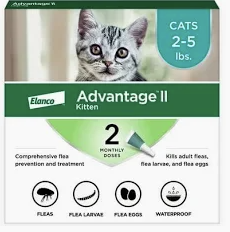Last Updated on 06/13/2025 by Kimberly
Newborn kittens are particularly at risk from fleas and it’s all about their delicate nature. These tiny creatures have thin skin and developing immune systems, making them extra vulnerable to infestations. A small number of fleas can quickly lead to serious health problems for these little ones. This is why it’s important to find the best flea treatment newborn kittens can use safely.
Fleas on newborn kittens can lead to anemia, which in simple terms, means they’re losing more blood than their little bodies can handle. That’s a serious issue and can even be life-threatening if not addressed promptly. Imagine a kitten feeling weak and losing weight rapidly—it’s heartbreaking.
Spotting fleas early can save a kitten’s life. But how do you do that when these pests are so sneaky? Look for black specks of flea dirt around their bedding or on their fur. Also, watch out for excessive scratching or restlessness; these signs often suggest a flea problem.
Understanding how and why kittens are affected by fleas can empower you to provide better care. You need to be constantly vigilant and proactive to protect these precious bundles of fur from such pests.
Safe Flea Treatments for Newborn Kittens
Finding a flea treatment that’s gentle enough for newborn kittens can be tricky, but there are some safe options out there. When dealing with such delicate creatures, it’s crucial to go for methods that are both effective and non-harmful.
Commercial flea treatments designed specifically for kittens are a starting point, but it’s important to read the labels closely. Many products are not suitable for use on kittens under a certain age or weight, so it’s all about making the right choice based on their specific needs.
Natural remedies, like using a simple mild dish soap bath, can be effective against fleas. The soap works by breaking down the fleas’ exoskeletons, causing them to die naturally. However, this method requires careful attention to avoid chilling the kittens, and it should be done gently and quickly.
Consulting a veterinarian before starting any flea treatment is always a smart move. A vet can recommend treatments based on the kitten’s age, weight, and overall health, ensuring what you use is both safe and effective.
Despite the urge to act fast when fleas are found, it’s worth noting that not all treatments are suitable for such young kittens. Keeping safety as the top priority ensures their health isn’t compromised while tackling the pesky flea problem.
Prevention Strategies: Protecting Newborn Kittens from Fleas
Creating a flea-free environment is a game-changer when it comes to keeping newborn kittens healthy. Start by ensuring their bedding is clean and fresh. Regularly washing and changing the bedding can help eliminate any lingering flea eggs or larvae, keeping the surroundings as pleasant and pest-free as possible.
Every visitor—from pets to humans—can be a potential carrier of fleas. If you’ve got other pets, keeping them on a reliable flea prevention program helps stop fleas from hitching a ride into your home. Guests could also unknowingly bring in pests, so it pays to keep an eye on any interactions with the kittens.
Vacuuming floors and carpets frequently is another trick to keep fleas at bay. This regular habit can remove any fleas, eggs, or larvae that might be lurking around. Consider using a pet-safe insect growth regulator spray that targets flea reproduction to add an extra layer of protection to your cleaning routine.
Minimal exposure is key; think about the kittens’ surroundings and keep them away from areas where fleas might be more prevalent, like backyards or gardens filled with wildlife. Keeping the kittens safe starts with minimizing their interaction with potential flea hotspots.
These prevention techniques are all about maintaining a safe perimeter around newborn kittens, reducing the chances of an infestation before it even begins.
Long-Term Care: When to Transition to Topical Monthly Flea Treatments
Transitioning newborn kittens to topical flea treatments requires a careful approach. The key is knowing when they are old enough and robust enough to handle these treatments safely. Generally, most topical treatments are not recommended until kittens reach at least eight weeks old, but always check the specific guidelines on whatever product you’re considering.
Before making the switch, assess the kitten’s health thoroughly. This means ensuring they’re at a healthy weight and showing no signs of illness. A weaker kitten may not react well to these treatments, so your vet’s advice is invaluable here.
Veterinary guidance can highlight the most suitable products tailored to their needs. Also, some kittens with sensitive skin might require more specialized treatments, making professional advice even more essential.
Once you start a topical treatment routine, monitor for any adverse reactions. It’s crucial to be vigilant about changes in behavior, appetite shifts, or skin irritation. If anything unusual occurs, reaching out to your vet right away can prevent any potential issues from escalating.
Embracing a long-term flea treatment plan not only shields your kittens from fleas as they grow but also ensures they develop into healthy adult cats without the worry of infestations.
In Conclusion To The Best Flea Treatment Newborn Kittens Can Use Safely:
One big mistake that many people do is treating kittens with flea medicines that are to strong for their systems to handle. When you jump to a flea med that is to high of a strength for your newborn kitten it can cause severe damage to their immune systems. Following the above information will allow you to treat your kittens safely and without severe side effects.
If you are treating a newborn kitten that you found abandoned and is covered in fleas, I personally would start with a mild dish soap, such as Dawn to bathe the kitten. Submerging the kitten in warm water will actually drown the fleas but, you need to keep them in the water for a period of time, about 15 minutes, for best results. While they are submerged in the water, with only their heads sticking out, make sure to push the fleas that come to the front of their heads back down into the water.
Use about a teaspoon of the mild dish soap and make a thick lather on your kittens coat, avoiding their face. The longer you can keep the thick lather on their coats, the better as the fleas are being smothered and suffocated. After about 5 min rinse the soap off of the kitten. Make sure to dry the kitten really well when you are done to avoid them from catching a chill.
This method is safe for kittens of all ages and will work well but you will also need to make sure that they have a safe flea free place to be when you are done.
I hope you found the information to treat your newborn kitten with fleas helpful. If you have any thoughts of your own to help others with their fight against fleas for newborn kittens, please leave it in the comments below to share with others. If you have any questions about any of the information in this article, please leave it in the comments section as well so we can help you the best we can.
Thank you for visiting Fleas B Gone 🙂





